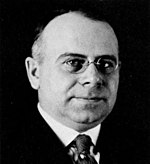Thomas Harris MacDonald

“Rugged integrity” . . . “Honesty” . . . “Fairness” . . . “Inspirational” . . . “Sound, far-sighted leadership” . . . “Dedicated public servant” and more were the expressions used by many who knew Thomas Harris MacDonald at the time of his retirement as Commissioner, Bureau of Public Roads. He had been head of the Bureau from 1919 to 1953, and during these years of his leadership, this Nation expanded its roadways from a scant ¼ of a million miles, of which very little was hard surfaced, to 3½ million miles of hard-surfaced, efficient, interstate roads; the Federal-State partnership in roadbuilding was developed and refined; the Alaska Highway was built and the Pan American Highway was well underway; and many of his staff worked with other countries in developing their roads and further training their engineers. Under MacDonald, the Bureau of Public Roads grew to become a center of highway research with worldwide influence.
Mr. MacDonald was born in Leadville, Colorado, on July 23, 1881, and moved with his family to Iowa in 1884. He studied at Iowa State College and received his bachelor’s degree in civil engineering in 1904. While at Iowa State, he developed an interest in highway engineering and, under the supervision of Dean Anson Marston, an early good roads proponent, did his undergraduate thesis on the highway needs of farmers and the force required to pull a wagon over different types of roads.
In 1904, the year MacDonald graduated, the Iowa Legislature designated the State College as a Commission to perform studies on highways and methods for their improvement. He took a position as an Assistant Professor of Civil Engineering and was placed in charge of road investigations. By 1907, at the age of 26, he was appointed State Highway Engineer, and in 1913, with the creation of a three-man State Highway Commission, he was appointed chief engineer. During his tenure with the Iowa State Highway Commission, Iowa became one of the first States in the Midwest to have a statewide system of main roads, with about one-third of the designated 6,400-mile network permanently graded, drained, and provided with bridges. MacDonald also developed plans for the hard surfacing of the roads. His success in improving the difficult Iowa roads attracted national attention among highway officials and the fledgling automobile industry. He became a leader among the highway officials of the ’teens and took an active part with the American Association of State Highway Officials (AASHO) in their efforts to secure Federal-aid highway legislation. This strong tie with AASHO and the various State highway officials was to remain constant throughout his professional life.
Then in 1919, Thomas MacDonald was called to Washington to serve as Chief of the Bureau of Public Roads, a position he was to hold through seven different presidents. President Wilson made his selection based upon the unanimous recommendations of the American Association of State Highway Officials. Though MacDonald's title changed over the course of the years, this original designation of “Chief” became synonymous with the man. It ceased to be just a title, but rather became a personal designation, applied with affection and admiration by an ever-widening circle of people around the world that included everyone with even the slightest interest in roads.
When the Chief took office, the 1916 Federal-Aid Road Act had been passed, but a program had not had a chance to get underway. Meanwhile, the first World War had ended, and the roads lay devastated by the effect of traffic, particularly that of heavy trucks and the inability to provide sufficient maintenance during the war effort. In addition, cooperation between BPR, the States, and Congress was needed to prepare the 1921 Federal Highway Act, which was intended to strengthen the 1916 Act. In general, in 1919, man’s maximum range of daily movement was still only 10 miles, and much work needed to be done.
176
